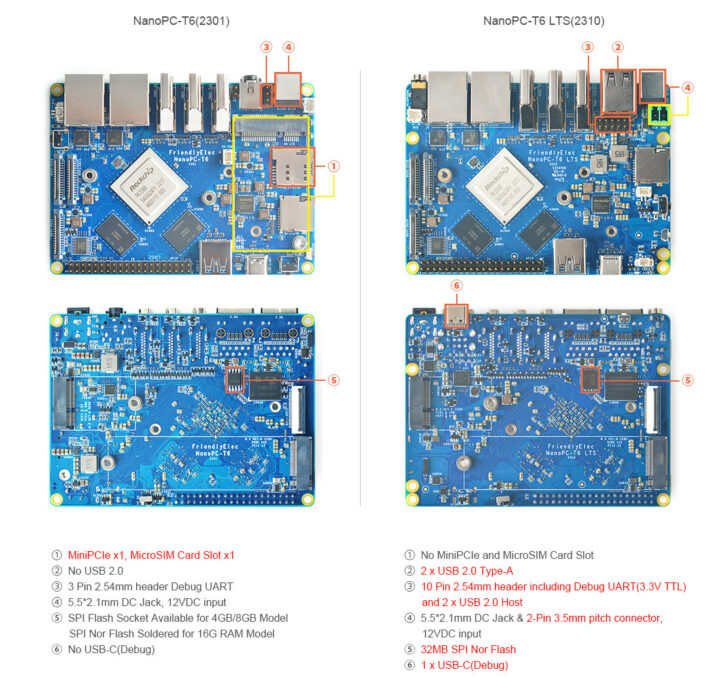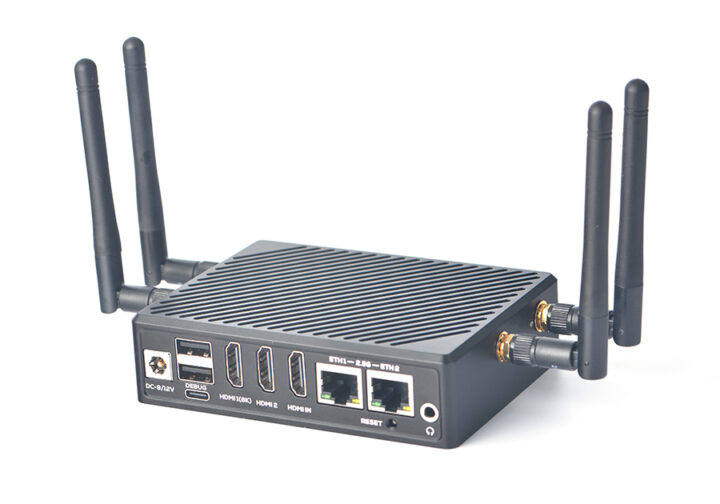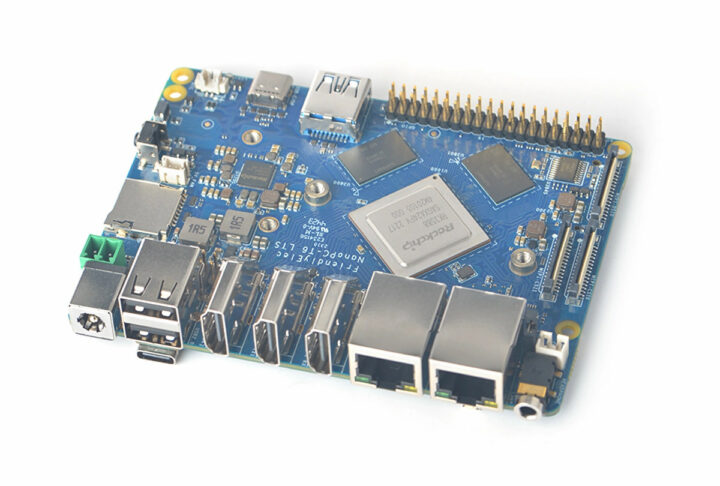NanoPC-T6 LTS is an update to the Rockchip RK3588-powered NanoPC-T6 SBC introduced in May 2023, which removes the mini PCIe socket and SIM card slot for 4G LTE connectivity, but adds two USB 2.0 ports, a USB-C debug port, a 10-pin header with UART and USB 2.0, and comes with 32MB SPI flash by default.
The single board computer is offered with up to 16GB RAM and 256GB eMMC flash and also features M.2 sockets for NVMe storage and a wireless module, two 2.5GbE RJ45 ports, two HDMI 2.1 output ports, one HDMI 2.0 input port, MIPI DSI and CSI interfaces, and a 40-pin GPIO header for expansion.
NanoPC-T6 LTS specifications with changes in bold or strikethrough:
- SoC – Rockchip RK3588
- CPU – Octa-core processor with 4x Cortex-A76 cores @ up to 2.4 GHz, 4x Cortex-A55 cores @ 1.8 GHz
- GPU – Arm Mali-G610 MP4 GPU with support for OpenGL ES 1.1, 2.0, and 3.2, OpenCL up to 2.2, and Vulkan 1.2
- AI accelerator – 6 TOPS NPU
- VPU – 8Kp60 H.265/VP9/AVS2 10-bit decoder, 8Kp30 H.264 decoder, 4Kp60 AV1 decoder, 8Kp30 H.265/H.264 encoder,
- System Memory – 64-bit 4GB, 8GB, or 16GB LPDDR4X at 2133MHz
- Storage
- 32GB, 64GB, or 256GB eMMC flash (HS400 mode)
- M.2 NVMe 2280 SSD socket
- MicroSD card slot up to SDR104 mode
- 32MB SPI flash
- Video
- Output
- 2x HDMI 2.1 ports one up to 8Kp60, the other up to 4Kp60
- 2x 4-lane MIPI-DSI up to 2560×1600 @ 60 Hz compatible with MIPI DPHY 2.0 or CPHY 1.1
- 1x USB-C (DisplayPort 1.4) up to 4Kp30
- Input
- 1x HDMI 2.0 input port up to 4Kp60
- 2x 4-lane MIPI-CSI compatible with MIPI V1.2
- Output
- Audio
- 3.5mm stereo audio jack (ALC5616)
- Digital audio via HDMI or DisplayPort
- 2.0mm PH-2A connector for analog microphone input
- Networking
- 2x 2.5GbE RJ45 ports via Realtek RTL8125BG controllers
- Optional WiFi and Bluetooth via M.2 module
Optional 4G LTE connectivity via mPCIe module + microSIM card slot
- 2x 2.5GbE RJ45 ports via Realtek RTL8125BG controllers
- USB
- 1x USB 3.0 Type-A port
- 1x USB 3.0 Type-C port with support for DisplayPort Alt. mode
- 2x USB 2.0 Type-A ports
- Expansion
- 40-pin GPIO header with up to 28x GPIOs, 6x UART, 1x I2C, 2x SPI, 8x PWM, 2x I2S
- M.2 Key-M socket with PCIe 3.0 x4 (typically used with an NVMe SSD)
- M.2 Key-E socket with PCIe 2.1 x1 and USB 2.0 host (typically used with a wireless module, whose support has just been added to mainline Linux.
mini PCIe socket and microSIM slot for cellular connectivity- 10-pin GPIO header with Debug UART (3.3V TTL) and 2x USB 2.0 host interfaces
- Debugging – USB-C debug port
- Misc
- Power, MASK (for eMMC update), and Reset buttons
- 2-pin connector for battery for the HYM8563TS RTC
- 5V fan connector
- 2x user LEDs
- 1x IR receiver
- Power on mode select jumper
3-pin 3.3V debug header (1,500,000 bps in firmware)
- Power Supply – 12V/2A via DC jack (5.5×2.1mm) or 2-pin connector
- Dimensions
- PCB: 110 x 80 mm (8-layer PCB); mounting holes for heatsink; mounting holes in all four corner
- Mini PC: 114 x 86 x30mm
- Weight – 91.5grams without case, 390grams with case
- Temperature Range – 0°C to +70°C

Another change is the ability to power the board through a 2-pin connector instead of the DC jack. So the new LTS is an upgrade, except for those who needed cellular connectivity, as they would need to rely on a 5G/4G LTE USB dongle instead.
The NanoPC-T6 LTS remains software-compatible with its predecessor and supports FriendlyWrt 21.02/22.03, Android 12 (Tablet/TV), FriendlyCore Lite 20.04, Debian 10 and 11 Desktop, Ubuntu 22.04 Desktop, and OpenMediaVault all based on Linux 6.1. It shares the same documentation as the earlier model.

Where it gets confusing is that the new NanoPC-T6 LTS launch does not mean the NanoPC-T6 entirely goes away and the company sells three variants of the boards:
- $119 – NanoPC-T6 LTS with 4GB RAM, 32GB eMMC flash, 32MB SPI flash
- $129 – NanoPC-T6 LTS with 8GB RAM, 64GB eMMC flash, 32MB SPI flash
- $169 – NanoPC-T6 with 16GB RAM, 256GB eMMC flash, 16MB SPI flash (still the old board)
The metal enclosure adds $20, an M.2 WiFi card with RTL8822CE WiFi 5 and Bluetooth 5.0 chips adds $18, and you’ll need to spend $9.89 if you want to purchase a 12V/2A power adapter too.

Jean-Luc started CNX Software in 2010 as a part-time endeavor, before quitting his job as a software engineering manager, and starting to write daily news, and reviews full time later in 2011.
Support CNX Software! Donate via cryptocurrencies, become a Patron on Patreon, or purchase goods on Amazon or Aliexpress





What have people been doing with HDMI input? It seems like it could be useful but I’m not sure.
There are some tablets adding display input that could be repurposed as external displays.
It’s recognized as a V4L2 interface so it’s like a camera input with both video and audio.
https://www.cnx-software.com/2022/07/20/rock-5b-rk3588-sbc-preview-what-works-what-doesnt-in-debian-11/#hdmi-input-on-rock-5b
It can usually be used for recording, broadcasting over TCP/UDP, and PiP.
IP KVM with HDMI input for display capture is one application potentially
“drops 4G LTE support” ?!?is only PPP interface
and they are losing customers with “financial” projects
Dropping lte m.2 module support, but usb will ofc still work
Better chose another vendor, this is not reliable. Ubuntu factory image of T6 would crash if 2 FullHD monitors were attached. But Debian image socks too. 2560p resolution is not supported. Only 1080p. Finally display in type C USB is not working. You have been warned!
Now *that* is getting quite interesting. We now have a full PC with console port for recovery and boot loader access, and the systematic SPI NOR which will support EDK2 (which already comes with pre-built images for this machine: https://github.com/edk2-porting/edk2-rk3588 ) so that any distro with a modern enough kernel will work out of the box. I hope they’ll pre-flash the boot loader on the SPI NOR so that it boots fine by default. Maybe the forthcoming ubuntu 24 will just work, like we’ve seen with previous versions on the latest librecomputer boards. I really appreciate the fact that FriendlyELEC… Read more »
It really makes me want to buy one to play with it but I’m unsure what I’ll do with it once I’m done playing. My rock5b is only seldom used and many of my boards are rarely used.
Owning SBC’s is very much like collecting stamps – they mostly attract dust when not stored properly.
Not really here. Sometimes scratches, but they mostly take room on the desk, power and even ethernet ports for all those that are always up “just in case” and to which I finally almost never connect.